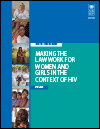Publications - Released in 2020
AIDS-related illnesses are the leading cause of death among women aged 15-49. Every day, an estimated 460 adolescent girls become infected with HIV. Gender inequality continues to contribute significantly to the spread of HIV leaving women and girls more vulnerable. Gender discriminatory laws, harmful traditional practices and gender-based violence reinforce unequal power dynamics between men and women, with adolescent girls and young women being particularly disadvantaged. Laws can either support efforts to fight HIV or present barriers to women’s and girls’ ability to access HIV and health services. Laws that sanction violence against women perpetuate gender inequality and negatively affect the HIV response for women and girls. As do criminal laws on HIV non-disclosure, exposure and transmission, sexual orientation, gender identity and expression, choice of work, recreational activities and access to sexual and reproductive health services.
Downloads
Organizations
- United Nations Development Programme (UNDP)






